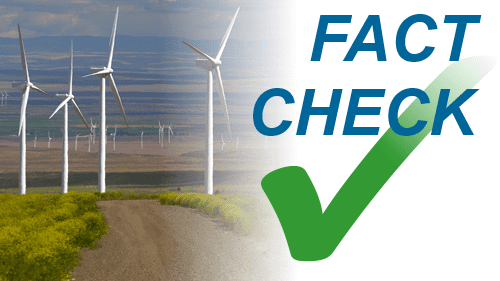Fact Check: Robert Bryce continues pushing anti-wind fallacies
Robert Bryce has a long history of promoting untruths about renewable energy. So much so that more than 50 journalists and educators once submitted a petition to then-New York Times Public Editor Arthur Brisbane, imploring the paper to call out the special interest funding ties of op-ed writers. They used Robert Bryce as their poster child for what was wrong with the Times’ process. The paper followed up with a piece entitled, “The Times Gives Them Space, but Who Pays Them?”
So it’s not surprising to see Bryce spreading more misinformation about wind energy in The Hill. Here’s a breakdown of what he gets wrong this time.
Error #1: Wind farms take up too much space
Bryce claims generating a sizeable portion of the country’s electricity using wind would take up too much space. However, the average wind farm leaves 98 percent of land undisturbed, leaving it free for other uses like farming and ranching. In fact, it’s possible to grow crops right up to the base of a wind turbine.
To make his point, Bryce cites a highly flawed 2018 Harvard study. At the time, AWEA and others highlighted deeply problematic assumptions used in the research and concluded, “The assumptions underlying their analysis are of an energy mix and technological deployment not grounded in reality.”
“This is by no means what future wind power in the U.S. will ever look like. It is an interesting theoretical exercise at best,” said Christina Archer, a wind expert from the University of Delaware.
Error #2: Wind and health concerns
Despite what Bryce would have you believe, there is no scientific evidence that wind turbines cause health issues. Millions of people around the world live and work near operating wind turbines without adverse health effects, and more than 20 credible, peer-reviewed scientific data and various government reports in the United States, Canada, Australia and the United Kingdom find wind farms pose no negative health effects.
The reality is generating more of our electricity using wind is a massive public health boon. By reducing particulate matter and air pollution that triggers asthma attacks and creates smog, wind avoids over $9 billion in public health costs every year. A Lawrence Berkley National Laboratory (LBNL) report found U.S. wind energy production from 2007 to 2015 generated up to $108 billion in air-quality and public health benefits, mainly by helping to avoid up to 12,200 premature deaths.
Error #3: Wind energy is unpopular
Poll after poll finds Americans across party lines overwhelmingly support growing wind energy. For example, a recent Pew poll found 85 percent of people support “more wind turbine farms.” That includes 79 percent who self-describe as Republican/lean Republican and 91 percent who self-describe as Democrat/lean Democrat. Over 99 percent of wind projects are built on private land as well, meaning projects only get built if people agree to host them.
In a 2017 LBNL study, researchers found 1.3 million homes in the U.S. are located within five miles of a wind turbine. In a representative survey of people living in these homes, LBNL found 92 percent of respondents reported positive or neutral experiences of the nearby wind turbine.
Robert Bryce has a long history of trying to muddy the waters when it comes to wind energy, and he hides potential conflicts of interest. For the real story, perhaps it’s best to hear straight from the people who live in communities with wind energy:




